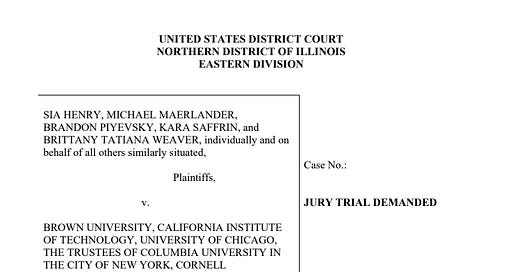Yesterday, the Wall Street Journal filed a report about price-fixing litigation launched against the 568 Presidents Group members, attracting quite a bit of attention. We will be following up with some financial analysis covering the suit but for now wanted to lay out a few details.
The suit is a private class-action suit brought on behalf of five plaintiffs, filed in federal court in Illinois. The suit alleges price-fixing with the intent to reduce or eliminate price competition among schools.
The schools being sued include many of the most selective colleges but not all of them. Harvard, Stanford and Princeton are not part of the 568 Group. Neither are big schools like UCLA, USC and other privates like Johns Hopkins or Tulane. The fact that certain highly selective schools are alleged to have conducted price fixing and some are not permits a cross-sectional financial comparison.
As of Fall 2018, the defendant schools had 112,208 undergraduates enrolled (on a full-time equivalent basis, so the full-time number would be a bit lower). Some articles cited 170,000 students, which likely includes graduate students, who would not be covered in the suit. To put this in context, this 112,208 represents under 1% of US college undergrads.
The lawsuit relies on Net Prices as compiled by IPEDS, among other facts. Net Prices are more useful for some programs than others, but they are particularly irrelevant to understanding what the average student pays at highly-selective private schools. For example, one of the defendants, the University of Pennsylvania reported an Average Net Price of $24,771 in 2018 when in fact the average first-year paid $51,189 net (using Average Net Cost). The core of the case rests on the construction of the group’s need-based aid methodology, so Net Price seems like a relevant metric, but the formula will also exclude certain students from qualifying for need-aid, making both measures informative.
The lawsuit cites actual quotes from a Yale admissions director stating outright that the group’s methodology lowered aid awards. Harvard is also directly quoted, explaining that its refusal to join the group was based on the desire to be more financially generous to its students. There also appears to be an issue with admitting waitlisted students, where need may have been factored into the decision. (Sara Harberson of Application Nation is quoted in the filing.) In general, the suit is packed with direct evidence of collusion and price-fixing by the 568 members.
The defendants include many of the most selective colleges but also ones farther down in selectivity rankings. Here are the 30 most selective colleges as of the 2019 admissions cycle:
Shaded schools are members of the 568 Group and are defendants. Unshaded are not involved. The table excludes specialty schools. Factlet: Stanford and Harvard are not the most selective colleges in the US. That distinction belongs to the Curtis Institute of Music in Philadelphia.
Other reading
The BIG blog, run by Matt Stoller and focussed on anti-trust issues, ran a slightly sensationalistic but worthwhile account titled: “Ivy League Cartel Sued for Price-Fixing.” Stoller makes this point:
what specifically makes someone ‘needy’ in a ‘need-blind’ system? The answer to that is an accounting question, so universities work together through an organization called the 568 President’s Group to set the terms for what makes someone needy. Now, if this also sounds like open price-fixing, that’s because it is. But done properly, it’s not necessarily illegal. The reason is universities have been caught before for price-fixing, and part of the settlement of that suit was that they were given an antitrust exemption so they could work together to price scholarships, within certain bounds…
Do these universities have a need-blind policy for all students? Most of them say that they do. But as it turns out, admissions officers have a nasty habit of letting in the children of the wealthy and powerful, in return for donations and prestige…
It’s a very clever suit, legally speaking. No one can reasonably dispute whether universities have colluded, or whether they maintain policies favoring potential donors. There's no need to establish a secret conspiracy, as it’s out in the open. The only real question is whether what universities have done is illegal. It’s a simple question of law, with few disputes on the facts. It’s no surprise that the suit was brought by some of the savvier plaintiff firms (Roche Freedman, Berger Montague, FeganScott, and Gilbert Litigators & Counselors).
Two Twitter threads also follow up:
Jon Boeckenstedt, a well-known edublogger and Vice President for Enrollment at Oregon State, is seemingly dismayed by the constant overexposure of highly selective schools (we sympathize) and takes a jaded tone: “I've been saying for years that need-blind admissions does not exist. It's not a luxury bestowed upon the vast majority of colleges, for one thing; and at the places that can afford it, well, you can see need in every line of an application.”
And Anna Ivey, a former dean of admissions, writes: “Buckle your seatbelts. If we get as big a data dump around financial aid in this lawsuit as we did around admissions practices in the affirmative action lawsuits, things are going to get really interesting. The discovery process is going to bonkers.” We are skeptical that discovery will rise to that level of interest but Ivey provides some nice details about the 1990s litigation, involving an overlapping but different set of colleges, and the consent decree that eventually led to the 568 Group.
We will return with a bit of financial analysis comparing the defendants with non-defendants in a later installment.
Please find more information at the CTAS site. CTAS provides data, reports and personalized assistance with college pricing and aid appeals.




